
Even at 96 years old, Iris Apfel continues to create. Her latest project is a return to the world of home decor, with her first ever collection of furniture to be sold exclusively on HSN.

Even at 96 years old, Iris Apfel continues to create. Her latest project is a return to the world of home decor, with her first ever collection of furniture to be sold exclusively on HSN.
Kevin struck Craigslist gold with this buffet. It had all of the proportions and details he was looking for and it was $Free$. He turned the buffet into a striking piece that brings out the best of the original features while adding some extra style.
Everyone feels something when they’re in a really good starry place on a really good starry night and they look up and see this:
Some people stick with the traditional, feeling struck by the epic beauty or blown away by the insane scale of the universe. Personally, I go for the old “existential meltdown followed by acting weird for the next half hour.” But everyone feels something.
Physicist Enrico Fermi felt something too—”Where is everybody?”
________________
A really starry sky seems vast—but all we’re looking at is our very local neighborhood. On the very best nights, we can see up to about 2,500 stars (roughly one hundred-millionth of the stars in our galaxy), and almost all of them are less than 1,000 light years away from us (or 1% of the diameter of the Milky Way). So what we’re really looking at is this:
When confronted with the topic of stars and galaxies, a question that tantalizes most humans is, “Is there other intelligent life out there?” Let’s put some numbers to it (if you don’t like numbers, just read the bold)—
As many stars as there are in our galaxy (100 – 400 billion), there are roughly an equal number of galaxies in the observable universe—so for every star in the colossal Milky Way, there’s a whole galaxy out there. All together, that comes out to the typically quoted range of between 1022 and 1024 total stars, which means that for every grain of sand on Earth, there are 10,000 stars out there.
The science world isn’t in total agreement about what percentage of those stars are “sun-like” (similar in size, temperature, and luminosity)—opinions typically range from 5% to 20%. Going with the most conservative side of that (5%), and the lower end for the number of total stars (1022), gives us 500 quintillion, or 500 billion billion sun-like stars.
There’s also a debate over what percentage of those sun-like stars might be orbited by an Earth-like planet (one with similar temperature conditions that could have liquid water and potentially support life similar to that on Earth). Some say it’s as high as 50%, but let’s go with the more conservative 22% that came out of a recent PNAS study. That suggests that there’s a potentially-habitable Earth-like planet orbiting at least 1% of the total stars in the universe—a total of 100 billion billion Earth-like planets.
So there are 100 Earth-like planets for every grain of sand in the world. Think about that next time you’re on the beach.
Moving forward, we have no choice but to get completely speculative. Let’s imagine that after billions of years in existence, 1% of Earth-like planets develop life (if that’s true, every grain of sand would represent one planet with life on it). And imagine that on 1% of those planets, the life advances to an intelligent level like it did here on Earth. That would mean there were 10 quadrillion, or 10 million billion intelligent civilizations in the observable universe.
Moving back to just our galaxy, and doing the same math on the lowest estimate for stars in the Milky Way (100 billion), we’d estimate that there are 1 billion Earth-like planets and 100,000 intelligent civilizations in our galaxy.[1]The Drake Equation provides a formal method for this narrowing-down process we’re doing.
SETI (Search for Extraterrestrial Intelligence) is an organization dedicated to listening for signals from other intelligent life. If we’re right that there are 100,000 or more intelligent civilizations in our galaxy, and even a fraction of them are sending out radio waves or laser beams or other modes of attempting to contact others, shouldn’t SETI’s satellite array pick up all kinds of signals?
But it hasn’t. Not one. Ever.
Where is everybody?
It gets stranger. Our sun is relatively young in the lifespan of the universe. There are far older stars with far older Earth-like planets, which should in theory mean civilizations far more advanced than our own. As an example, let’s compare our 4.54 billion-year-old Earth to a hypothetical 8 billion-year-old Planet X.
If Planet X has a similar story to Earth, let’s look at where their civilization would be today (using the orange timespan as a reference to show how huge the green timespan is):
The technology and knowledge of a civilization only 1,000 years ahead of us could be as shocking to us as our world would be to a medieval person. A civilization 1 million years ahead of us might be as incomprehensible to us as human culture is to chimpanzees. And Planet X is 3.4 billion years ahead of us…
There’s something called The Kardashev Scale, which helps us group intelligent civilizations into three broad categories by the amount of energy they use:
A Type I Civilization has the ability to use all of the energy on their planet. We’re not quite a Type I Civilization, but we’re close (Carl Sagan created a formula for this scale which puts us at a Type 0.7 Civilization).
A Type II Civilization can harness all of the energy of their host star. Our feeble Type I brains can hardly imagine how someone would do this, but we’ve tried our best, imagining things like a Dyson Sphere.
A Type III Civilization blows the other two away, accessing power comparable to that of the entire Milky Way galaxy.
If this level of advancement sounds hard to believe, remember Planet X above and their 3.4 billion years of further development. If a civilization on Planet X were similar to ours and were able to survive all the way to Type III level, the natural thought is that they’d probably have mastered inter-stellar travel by now, possibly even colonizing the entire galaxy.
One hypothesis as to how galactic colonization could happen is by creating machinery that can travel to other planets, spend 500 years or so self-replicating using the raw materials on their new planet, and then send two replicas off to do the same thing. Even without traveling anywhere near the speed of light, this process would colonize the whole galaxy in 3.75 million years, a relative blink of an eye when talking in the scale of billions of years:
Source: Scientific American: “Where Are They”
Continuing to speculate, if 1% of intelligent life survives long enough to become a potentially galaxy-colonizing Type III Civilization, our calculations above suggest that there should be at least 1,000 Type III Civilizations in our galaxy alone—and given the power of such a civilization, their presence would likely be pretty noticeable. And yet, we see nothing, hear nothing, and we’re visited by no one.
So where is everybody?
_____________________
Welcome to the Fermi Paradox.
We have no answer to the Fermi Paradox—the best we can do is “possible explanations.” And if you ask ten different scientists what their hunch is about the correct one, you’ll get ten different answers. You know when you hear about humans of the past debating whether the Earth was round or if the sun revolved around the Earth or thinking that lightning happened because of Zeus, and they seem so primitive and in the dark? That’s about where we are with this topic.
In taking a look at some of the most-discussed possible explanations for the Fermi Paradox, let’s divide them into two broad categories—those explanations which assume that there’s no sign of Type II and Type III Civilizations because there are none of them out there, and those which assume they’re out there and we’re not seeing or hearing anything for other reasons:
Explanation Group 1: There are no signs of higher (Type II and III) civilizations because there are no higher civilizations in existence.
Those who subscribe to Group 1 explanations point to something called the non-exclusivity problem, which rebuffs any theory that says, “There are higher civilizations, but none of them have made any kind of contact with us because they all _____.” Group 1 people look at the math, which says there should be so many thousands (or millions) of higher civilizations, that at least one of them would be an exception to the rule. Even if a theory held for 99.99% of higher civilizations, the other .01% would behave differently and we’d become aware of their existence.
Therefore, say Group 1 explanations, it must be that there are no super-advanced civilizations. And since the math suggests that there are thousands of them just in our own galaxy, something else must be going on.
This something else is called The Great Filter.
The Great Filter theory says that at some point from pre-life to Type III intelligence, there’s a wall that all or nearly all attempts at life hit. There’s some stage in that long evolutionary process that is extremely unlikely or impossible for life to get beyond. That stage is The Great Filter.
If this theory is true, the big question is, Where in the timeline does the Great Filter occur?
It turns out that when it comes to the fate of humankind, this question is very important. Depending on where The Great Filter occurs, we’re left with three possible realities: We’re rare, we’re first, or we’re fucked.
1. We’re Rare (The Great Filter is Behind Us)
One hope we have is that The Great Filter is behind us—we managed to surpass it, which would mean it’s extremely rare for life to make it to our level of intelligence. The diagram below shows only two species making it past, and we’re one of them.
This scenario would explain why there are no Type III Civilizations…but it would also mean that we could be one of the few exceptions now that we’ve made it this far. It would mean we have hope. On the surface, this sounds a bit like people 500 years ago suggesting that the Earth is the center of the universe—it implies that we’re special. However, something scientists call “observation selection effect” suggests that anyone who is pondering their own rarity is inherently part of an intelligent life “success story”—and whether they’re actually rare or quite common, the thoughts they ponder and conclusions they draw will be identical. This forces us to admit that being special is at least a possibility.
And if we are special, when exactly did we become special—i.e. which step did we surpass that almost everyone else gets stuck on?
One possibility: The Great Filter could be at the very beginning—it might be incredibly unusual for life to begin at all. This is a candidate because it took about a billion years of Earth’s existence to finally happen, and because we have tried extensively to replicate that event in labs and have never been able to do it. If this is indeed The Great Filter, it would mean that not only is there no intelligent life out there, there may be no other life at all.
Another possibility: The Great Filter could be the jump from the simple prokaryote cell to the complex eukaryote cell. After prokaryotes came into being, they remained that way for almost two billion years before making the evolutionary jump to being complex and having a nucleus. If this is The Great Filter, it would mean the universe is teeming with simple prokaryote cells and almost nothing beyond that.
There are a number of other possibilities—some even think the most recent leap we’ve made to our current intelligence is a Great Filter candidate. While the leap from semi-intelligent life (chimps) to intelligent life (humans) doesn’t at first seem like a miraculous step, Steven Pinker rejects the idea of an inevitable “climb upward” of evolution: “Since evolution does not strive for a goal but just happens, it uses the adaptation most useful for a given ecological niche, and the fact that, on Earth, this led to technological intelligence only once so far may suggest that this outcome of natural selection is rare and hence by no means a certain development of the evolution of a tree of life.”
Most leaps do not qualify as Great Filter candidates. Any possible Great Filter must be one-in-a-billion type thing where one or more total freak occurrences need to happen to provide a crazy exception—for that reason, something like the jump from single-cell to multi-cellular life is ruled out, because it has occurred as many as 46 times, in isolated incidents, just on this planet alone. For the same reason, if we were to find a fossilized eukaryote cell on Mars, it would rule the above “simple-to-complex cell” leap out as a possible Great Filter (as well as anything before that point on the evolutionary chain)—because if it happened on both Earth and Mars, it’s almost definitely not a one-in-a-billion freak occurrence.
If we are indeed rare, it could be because of a fluky biological event, but it also could be attributed to what is called the Rare Earth Hypothesis, which suggests that though there may be many Earth-like planets, the particular conditions on Earth—whether related to the specifics of this solar system, its relationship with the moon (a moon that large is unusual for such a small planet and contributes to our particular weather and ocean conditions), or something about the planet itself—are exceptionally friendly to life.
2. We’re the First
For Group 1 Thinkers, if the Great Filter is not behind us, the one hope we have is that conditions in the universe are just recently, for the first time since the Big Bang, reaching a place that would allow intelligent life to develop. In that case, we and many other species may be on our way to super-intelligence, and it simply hasn’t happened yet. We happen to be here at the right time to become one of the first super-intelligent civilizations.
One example of a phenomenon that could make this realistic is the prevalence of gamma-ray bursts, insanely huge explosions that we’ve observed in distant galaxies. In the same way that it took the early Earth a few hundred million years before the asteroids and volcanoes died down and life became possible, it could be that the first chunk of the universe’s existence was full of cataclysmic events like gamma-ray bursts that would incinerate everything nearby from time to time and prevent any life from developing past a certain stage. Now, perhaps, we’re in the midst of an astrobiological phase transition and this is the first time any life has been able to evolve for this long, uninterrupted.
3. We’re Fucked (The Great Filter is Ahead of Us)
If we’re neither rare nor early, Group 1 thinkers conclude that The Great Filter must be in our future. This would suggest that life regularly evolves to where we are, but that something prevents life from going much further and reaching high intelligence in almost all cases—and we’re unlikely to be an exception.
One possible future Great Filter is a regularly-occurring cataclysmic natural event, like the above-mentioned gamma-ray bursts, except they’re unfortunately not done yet and it’s just a matter of time before all life on Earth is suddenly wiped out by one. Another candidate is the possible inevitability that nearly all intelligent civilizations end up destroying themselves once a certain level of technology is reached.
This is why Oxford University philosopher Nick Bostrom says that “no news is good news.” The discovery of even simple life on Mars would be devastating, because it would cut out a number of potential Great Filters behind us. And if we were to find fossilized complex life on Mars, Bostrom says “it would be by far the worst news ever printed on a newspaper cover,” because it would mean The Great Filter is almost definitely ahead of us—ultimately dooming the species. Bostrom believes that when it comes to The Fermi Paradox, “the silence of the night sky is golden.”
Explanation Group 2: Type II and III intelligent civilizations are out there—and there are logical reasons why we might not have heard from them.
Group 2 explanations get rid of any notion that we’re rare or special or the first at anything—on the contrary, they believe in the Mediocrity Principle, whose starting point is that there is nothing unusual or rare about our galaxy, solar system, planet, or level of intelligence, until evidence proves otherwise. They’re also much less quick to assume that the lack of evidence of higher intelligence beings is evidence of their nonexistence—emphasizing the fact that our search for signals stretches only about 100 light years away from us (0.1% across the galaxy) and suggesting a number of possible explanations. Here are 10:
Possibility 1) Super-intelligent life could very well have already visited Earth, but before we were here. In the scheme of things, sentient humans have only been around for about 50,000 years, a little blip of time. If contact happened before then, it might have made some ducks flip out and run into the water and that’s it. Further, recorded history only goes back 5,500 years—a group of ancient hunter-gatherer tribes may have experienced some crazy alien shit, but they had no good way to tell anyone in the future about it.
Possibility 2) The galaxy has been colonized, but we just live in some desolate rural area of the galaxy. The Americas may have been colonized by Europeans long before anyone in a small Inuit tribe in far northern Canada realized it had happened. There could be an urbanization component to the interstellar dwellings of higher species, in which all the neighboring solar systems in a certain area are colonized and in communication, and it would be impractical and purposeless for anyone to deal with coming all the way out to the random part of the spiral where we live.
Possibility 3) The entire concept of physical colonization is a hilariously backward concept to a more advanced species. Remember the picture of the Type II Civilization above with the sphere around their star? With all that energy, they might have created a perfect environment for themselves that satisfies their every need. They might have crazy-advanced ways of reducing their need for resources and zero interest in leaving their happy utopia to explore the cold, empty, undeveloped universe.
An even more advanced civilization might view the entire physical world as a horribly primitive place, having long ago conquered their own biology and uploaded their brains to a virtual reality, eternal-life paradise. Living in the physical world of biology, mortality, wants, and needs might seem to them the way we view primitive ocean species living in the frigid, dark sea. FYI, thinking about another life form having bested mortality makes me incredibly jealous and upset.
Possibility 4) There are scary predator civilizations out there, and most intelligent life knows better than to broadcast any outgoing signals and advertise their location. This is an unpleasant concept and would help explain the lack of any signals being received by the SETI satellites. It also means that we might be the super naive newbies who are being unbelievably stupid and risky by ever broadcasting outward signals. There’s a debate going on currently about whether we should engage in METI (Messaging to Extraterrestrial Intelligence—the reverse of SETI) or not, and most people say we should not. Stephen Hawking warns, “If aliens visit us, the outcome would be much as when Columbus landed in America, which didn’t turn out well for the Native Americans.” Even Carl Sagan (a general believer that any civilization advanced enough for interstellar travel would be altruistic, not hostile) called the practice of METI “deeply unwise and immature,” and recommended that “the newest children in a strange and uncertain cosmos should listen quietly for a long time, patiently learning about the universe and comparing notes, before shouting into an unknown jungle that we do not understand.” Scary.[2]Thinking about this logically, I think we should disregard all the warnings get the outgoing signals rolling. If we catch the attention of super-advanced beings, yes, they might decide to wipe out our whole existence, but that’s not that different than our current fate (to each die within a century). And maybe, instead, they’d invite us to upload our brains into their eternal virtual utopia, which would solve the death problem and also probably allow me to achieve my childhood dream of bouncing around on the clouds. Sounds like a good gamble to me.
Possibility 5) There’s only one instance of higher-intelligent life—a “superpredator” civilization (like humans are here on Earth)—who is far more advanced than everyone else and keeps it that way by exterminating any intelligent civilization once they get past a certain level. This would suck. The way it might work is that it’s an inefficient use of resources to exterminate all emerging intelligences, maybe because most die out on their own. But past a certain point, the super beings make their move—because to them, an emerging intelligent species becomes like a virus as it starts to grow and spread. This theory suggests that whoever was the first in the galaxy to reach intelligence won, and now no one else has a chance. This would explain the lack of activity out there because it would keep the number of super-intelligent civilizations to just one.
Possibility 6) There’s plenty of activity and noise out there, but our technology is too primitive and we’re listening for the wrong things. Like walking into a modern-day office building, turning on a walkie-talkie, and when you hear no activity (which of course you wouldn’t hear because everyone’s texting, not using walkie-talkies), determining that the building must be empty. Or maybe, as Carl Sagan has pointed out, it could be that our minds work exponentially faster or slower than another form of intelligence out there—e.g. it takes them 12 years to say “Hello,” and when we hear that communication, it just sounds like white noise to us.
Possibility 7) We are receiving contact from other intelligent life, but the government is hiding it. This is an idiotic theory, but I had to mention it because it’s talked about so much.
Possibility 8) Higher civilizations are aware of us and observing us (AKA the “Zoo Hypothesis”). As far as we know, super-intelligent civilizations exist in a tightly-regulated galaxy, and our Earth is treated like part of a vast and protected national park, with a strict “Look but don’t touch” rule for planets like ours. We wouldn’t notice them, because if a far smarter species wanted to observe us, it would know how to easily do so without us realizing it. Maybe there’s a rule similar to the Star Trek’s “Prime Directive” which prohibits super-intelligent beings from making any open contact with lesser species like us or revealing themselves in any way, until the lesser species has reached a certain level of intelligence.
Possibility 9) Higher civilizations are here, all around us. But we’re too primitive to perceive them. Michio Kaku sums it up like this:
Lets say we have an ant hill in the middle of the forest. And right next to the ant hill, they’re building a ten-lane super-highway. And the question is “Would the ants be able to understand what a ten-lane super-highway is? Would the ants be able to understand the technology and the intentions of the beings building the highway next to them?
So it’s not that we can’t pick up the signals from Planet X using our technology, it’s that we can’t even comprehend what the beings from Planet X are or what they’re trying to do. It’s so beyond us that even if they really wanted to enlighten us, it would be like trying to teach ants about the internet.
Along those lines, this may also be an answer to “Well if there are so many fancy Type III Civilizations, why haven’t they contacted us yet?” To answer that, let’s ask ourselves—when Pizarro made his way into Peru, did he stop for a while at an anthill to try to communicate? Was he magnanimous, trying to help the ants in the anthill? Did he become hostile and slow his original mission down in order to smash the anthill apart? Or was the anthill of complete and utter and eternal irrelevance to Pizarro? That might be our situation here.
Possibility 10) We’re completely wrong about our reality. There are a lot of ways we could just be totally off with everything we think. The universe might appear one way and be something else entirely, like a hologram. Or maybe we’re the aliens and we were planted here as an experiment or as a form of fertilizer. There’s even a chance that we’re all part of a computer simulation by some researcher from another world, and other forms of life simply weren’t programmed into the simulation.
________________
As we continue along with our possibly-futile search for extraterrestrial intelligence, I’m not really sure what I’m rooting for. Frankly, learning either that we’re officially alone in the universe or that we’re officially joined by others would be creepy, which is a theme with all of the surreal storylines listed above—whatever the truth actually is, it’s mindblowing.
Beyond its shocking science fiction component, The Fermi Paradox also leaves me with a deep humbling. Not just the normal “Oh yeah, I’m microscopic and my existence lasts for three seconds” humbling that the universe always triggers. The Fermi Paradox brings out a sharper, more personal humbling, one that can only happen after spending hours of research hearing your species’ most renowned scientists present insane theories, change their minds again and again, and wildly contradict each other—reminding us that future generations will look at us the same way we see the ancient people who were sure that the stars were the underside of the dome of heaven, and they’ll think “Wow they really had no idea what was going on.”
Compounding all of this is the blow to our species’ self-esteem that comes with all of this talk about Type II and III Civilizations. Here on Earth, we’re the king of our little castle, proud ruler of the huge group of imbeciles who share the planet with us. And in this bubble with no competition and no one to judge us, it’s rare that we’re ever confronted with the concept of being a dramatically inferior species to anyone. But after spending a lot of time with Type II and III Civilizations over the past week, our power and pride are seeming a bit David Brent-esque.
That said, given that my normal outlook is that humanity is a lonely orphan on a tiny rock in the middle of a desolate universe, the humbling fact that we’re probably not as smart as we think we are, and the possibility that a lot of what we’re sure about might be wrong, sounds wonderful. It opens the door just a crack that maybe, just maybe, there might be more to the story than we realize.
To humble you further:
More from Wait But Why:
Why Generation Y Yuppies Are Unhappy
7 Ways to be Insufferable on Facebook
Why Procrastinators Procrastinate
How to Name a Baby
How to Pick Your Life Partner
Your Life in Weeks
10 Types of 30-Year-Old Single Guys
The Great Perils of Social Interaction
Sources:
PNAS: Prevalence of Earth-size planets orbiting Sun-like stars
SETI: The Drake Equation
NASA: Workshop Report on the Future of Intelligence In The Cosmos
Keith Wiley: The Fermi Paradox, Self-Replicating Probes, and the Interstellar Transportation Bandwidth
NCBI: Astrobiological phase transition: towards resolution of Fermi’s paradox
André Kukla: Extraterrestrials: A Philosophical Perspective
Nick Bostrom: Where Are They?
Science Direct: Galactic gradients, postbiological evolution and the apparent failure of SETI
Nature: Simulations back up theory that Universe is a hologram
Robin Hanson: The Great Filter – Are We Almost Past It?
John Dyson: Search for Artificial Stellar Sources of Infrared Radiation
The post The Fermi Paradox appeared first on Wait But Why.
If you’re not sure what Odd Things in Odd Places is and why I’m in Iraq by myself, here’s why.
_______________
On the morning of Saturday, August 2nd, I got in a taxi in Erbil, the regional capital of Kurdish Iraq, and asked the driver to take me to the Khazir refugee camp.
This was a scary-ish thing to do.
The “scary” part is a result of the fact that the Khazir camp is outside of the borders of the somewhat autonomous Kurdish region, one of the only secure parts of the country.
The “ish” part comes from the fact that the Khazir camp, though outside of Kurdish borders, is still in an area currently controlled by the Peshmerga—the Kurdish army.
Iraq has been a scary place for a while now, for a number of reasons, but it’s currently scary in italics because of the terrorist group we’ve all gotten to know about in the past three months—ISIS.
So, the cab driver, myself, and our two constricted assholes headed west towards Khazir.
After about 45 minutes, we crossed the checkpoint that meant we were leaving the Kurdish region, and a few minutes later, right when my phone’s blue dot was starting to get just close enough to Mosul for my liking, I looked out the car’s right window and saw the camp:
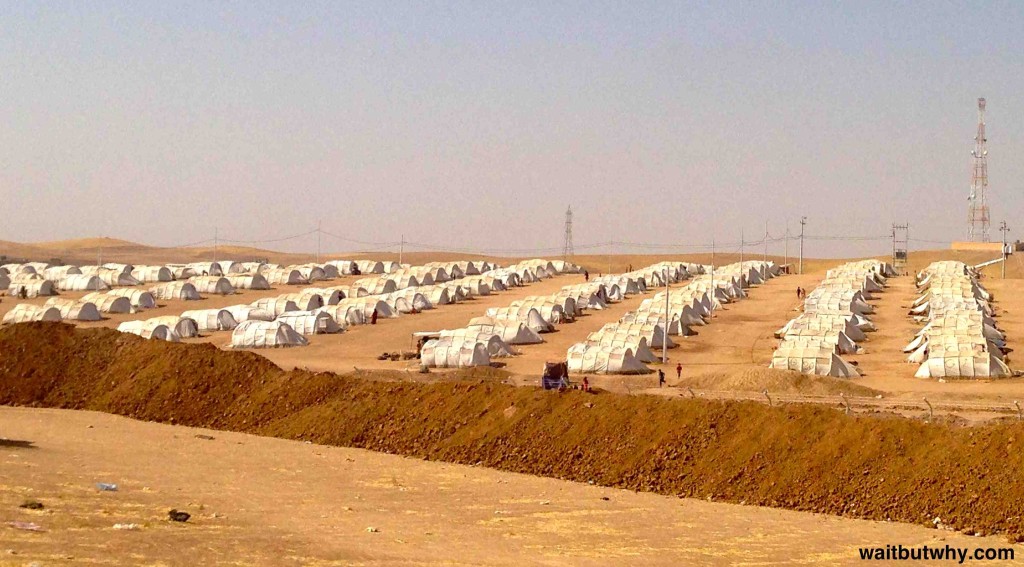
We pulled in, spent a bunch of time convincing the camp officials and ourselves that I was a journalist, and eventually I was allowed in.
I didn’t have a plan, exactly, so I started walking through the long lines of tents, noting that the 118°F (48°C) temperature I had been suffering through all week must be almost lethal here, where the only escape was in a tent.
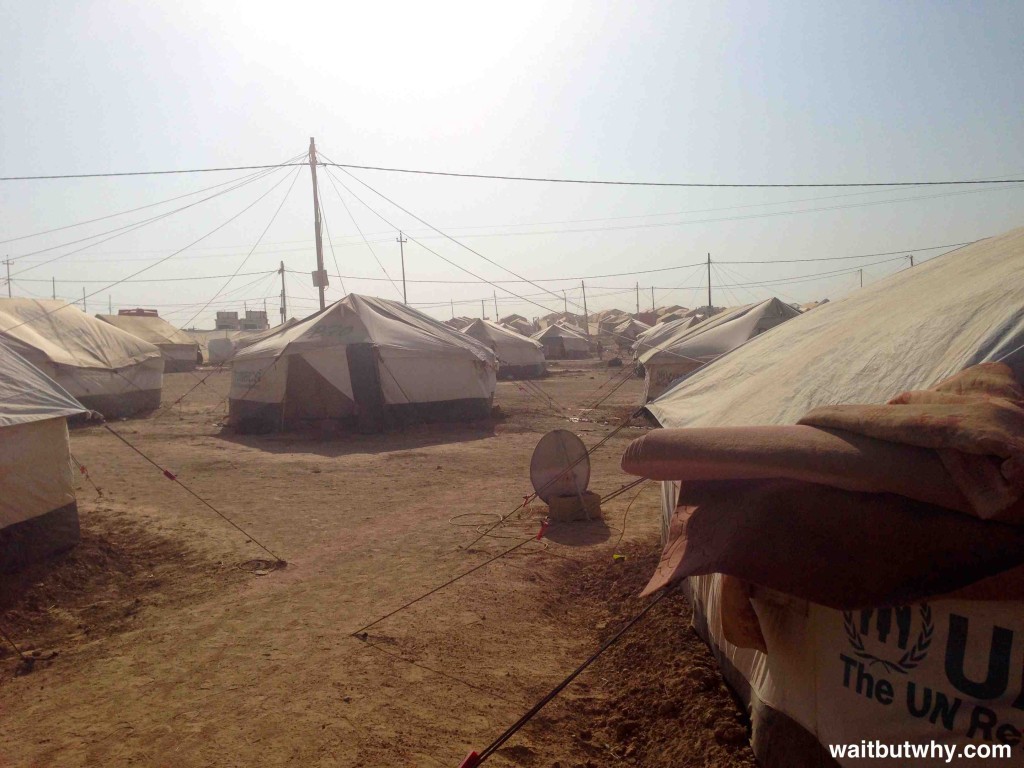
After a few minutes, I met a man named Kamil who spoke some English, and he invited me into his family’s tent. After talking with him a bit, I learned that it was actually a few families’ tent, and that there were 12 people living in it—five adults and seven children. There was electricity enough for a TV and a fan, and most of the mattresses were stacked on the side.

He told me that 12 people to a tent was common at the camp, and mentioned that his tent was actually about to move to 13, gesturing toward one of the women living there who was thoroughly pregnant.
Kamil was from Mosul, like everyone at the camp. Mosul is Iraq’s second largest city, only 30 miles west of the camp—and as of June 9th, an ISIS stronghold. After taking over, one of the first orders of business for ISIS was rounding up government workers for execution. Kamil, a police officer, was lucky to get out with his family before they got to him. When I asked him if he thought he’d return to Mosul at some point, he shook his head and said, “Fuck Mosul.”
As soon as he learned that I was going to be writing about my time in Iraq, he led me out of the tent to join him on a special Oh Okay Then I Want to Show You Exactly How Upsetting Everything Here Is So You Can Write About It and Tell Everyone Tour.
He walked me past the communal tap for drinking water, and said people used that water to clean themselves too, having not seen a shower since they arrived.

He showed me multiple babies that had been born at the camp.
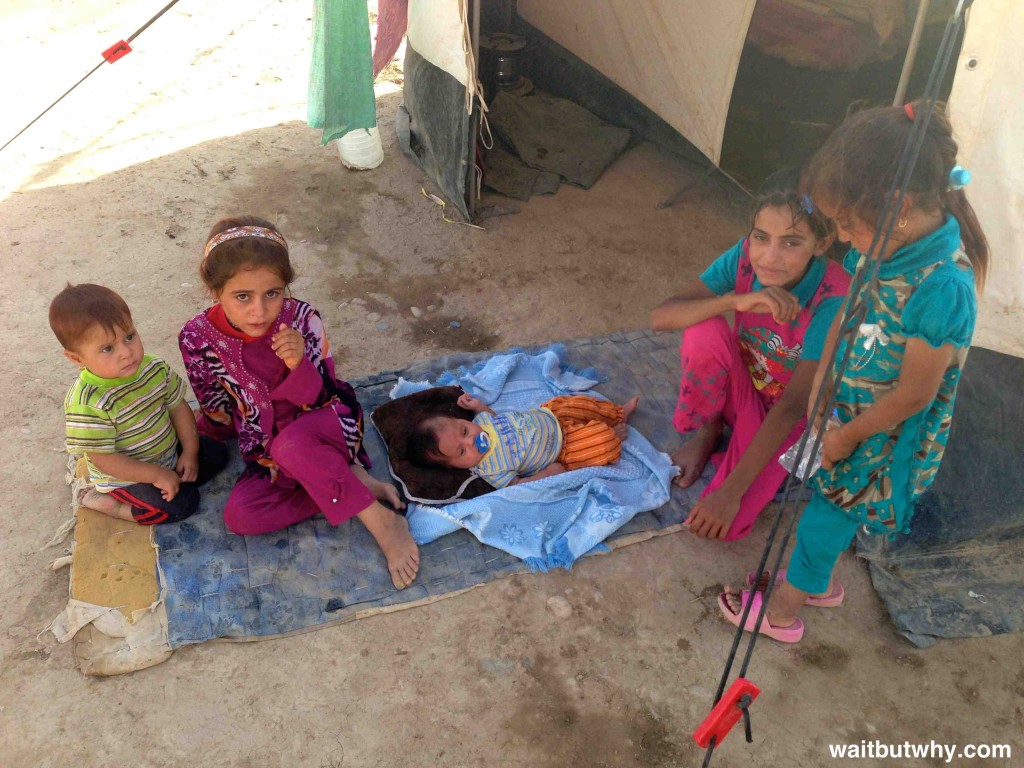
We popped into a bunch of different tents, one whose fan had been stolen (remember that it’s 118°), and another that had 15 people living in it. He showed me where the shared toilets drain out into a system that flows openly through the camp. He told me that a lot of the families didn’t have enough food and that people were getting sick more and more often and remaining untreated. And these were all people who two months earlier were living their normal lives in their normal homes. Remember the time I complained about anything? That was dumb.
When Kamil introduced me to a man whose two brothers had been executed by ISIS, I assumed that had to be the tour’s horrifying grand finale, but he wasn’t done yet. He brought me into another tent where he introduced me to a woman living there, explaining to her that I was his new writer friend. Without missing a beat, she handed me these:

Whatever I was holding, it was something bad, and I didn’t want to ask what it was. I asked. He pointed across the tent to a little boy and explained that I was holding part of his skull.
The boy was an eight-year-old named Mohammad. Their family’s house had been bombed in the middle of the night during the first days of the ISIS takeover and subsequent Iraqi government airstrikes. I never learned why or if they were specifically targeted. But the end result was that this healthy little eight-year-old—

—was now this brain-damaged, partially deaf, blind in one eye eight-year-old with digestive difficulties:

The goal of this post will be to understand why this sickening thing happened to this little boy—to really understand what’s going on in that country—better than you do now.
And if we really want to wrap our head around things, we have to start way, way back—in 570 AD.
_______________
Ingredient 1: An Ancient Schism
In 570, a long-named baby was born to a prominent family in Mecca, a city on the west coast of what is currently Saudi Arabia—Abū al-Qāsim Muḥammad ibn ʿAbd Allāh ibn ʿAbd al-Muṭṭalib ibn Hāshim. Today he’s just known as Muhammad.1 ← click this
Muhammad never had a father—his father died six months before his birth—and his mother died when he was six years old.2 ← again again
After the death of his mother, Muhammad lived with his grandfather, and when he died two years later, Muhammad was transferred to his uncle, a merchant. With his uncle as his mentor, Muhammad became a merchant himself. Not too much is known about Muhammad’s young adult years, but one thing we’re pretty sure of is that he married a 40-year-old widow named Khadijah when he was 25 (he’d have multiple more wives later in his life). They would go on to have four daughters and two sons, only one of whom survived into full adulthood—his daughter Fatimah.
It wasn’t until Muhammad was 40 that his life started getting strange. He had gotten into the habit of going up to a mountain every year for a couple weeks to be alone, meditate, and pray. It was on one of these solo retreats in 610 AD that Muhammad was for the first time visited by the angel Gabriel.3 As the story goes, Gabriel recited messages to Muhammad that were directly from God, which Muhammad memorized. Over the years, Gabriel would continue to visit Muhammad with messages, Muhammad continued to commit them to memory, and later, he would recite the memories to his followers, who would then write them down, and that became the Quran.
Three years after the first visit from Gabriel, in 613, Muhammad began preaching the messages to the public, in his hometown of Mecca. This did not go well. At the time, Mecca was largely made up of polytheistic tribes who worshipped nature-related gods and goddesses, and one of Muhammad’s main messages was that there was one god and any idols to other gods should be destroyed, which was awkward for everybody. People started reacting violently to Muhammad’s growing influence, killing some of his followers, and they may have killed Muhammad too had he not belonged to a fancy family. But in 622, when Muhammad learned of an assassination plot against him, he and his followers decided to bail on Mecca and head to the nearby city of Medina. This journey is called the Hijra in Muslim tradition and it’s celebrated on the first day of the Muslim year.
Muhammad and his followers would spend the next eight years fighting off attempts to destroy them from Mecca and other places, and often being ruthless themselves with those who posed a threat to Islam or refused to convert. The thing a lot of people don’t know is that in addition to being a spiritual leader, Muhammad was, in essence, the general of an army of followers and a tremendously effective strategist in growing and holding on to his leadership position in the face of lots of hostile competition.
Things came to a head in 625 when the Meccans, who were increasingly losing prestige and support as Muhammad’s following continued to grow, launched an attack on Medina and defeated the Muslims. But five years later, Muhammad and a 10,000 man army marched into Mecca and conquered it for good. By the time Muhammad died in 632, Islam had spread through the whole Arabian Peninsula.
The Muslim World Splits
The new Muslim world enjoyed 20 years of internal unity until Muhammad died, and then that was the end of that, forever.
The problem is that Muhammad didn’t appoint a successor before he died, or if he did, he didn’t get the word out to everyone. And because he had no living sons, there was no obvious answer. Here’s what happened:
Group A thought that Muhammad wanted the elite members of the Muslim community to choose a fitting leader, or caliph, and whenever that caliph died, the elite would choose the next leader, and so on. And Group A decided a great first caliph to succeed Muhammad would be the father of one of Muhammad’s wives, Abu Bakr (we’ll call him Abu).
Group B disagreed. They thought Muhammad would have told them that only God can choose the successor to lead the Muslim world, and that could only happen by keeping things in the family. To them, all signs pointed to Muhammad’s cousin and the husband of his daughter Fatimah, Ali ibn Abi Talib (Ali).
Group A was bigger and it won.
So father-in-law Abu took over as Caliph, while son-in-law Ali watched from the sidelines and Group B seethed.
When Abu died of illness two years after taking over, another friend of Muhammad’s, Umar, took over, having been appointed by Abu before his death. Umar ruled for ten years before he was assassinated by the Persians he had just conquered. Abu had also appointed Umar’s successor, Uthman, who ruled for 12 years before he was assassinated. All the while, Group B is helpless and frustrated.
But then, the elite decided the next and fourth caliph should be Ali—Group B’s original guy—and for two seconds, everyone was happy.
Five years later, Ali was assassinated, and when his eldest son Hassan became the fifth caliph, he was quickly overpowered by an aggressive rebel force led by Muawiyah, who coerced Hassan out of power and became the sixth caliph—and Group A and Group B would never reconcile again. While Muawiyah was the first of a long dynasty of caliphs, Group B tells a different story. To them, the leaders are more special than merely elected caliphs—they’re divinely chosen imams, and the way they see it, after an annoying three-caliph delay, their first imam was finally in power when Ali got the job. His eldest son Hassan was their second imam, and when Muawiyah kicked him out, Group B threw their support behind Ali’s younger son, Husayn—their third imam.
Husayn, Group B’s third imam, ended up being beheaded by Yazid, Group A’s seventh caliph (Muawiyah’s successor), and so Group B moved onto Husayn’s son as their fourth imam, while Group A continued to ignore Group B and support their caliphs.
This was over 1300 years ago, and yet today’s Muslim world is still completely divided over it, and so much of today’s Middle East strife is centered around this ancient split.
Group A are Sunnis and Group B are Shias.
Today’s Sunni-Shia tensions are about a lot of things, but at their very core is what happened in the 7th century. Sunni Muslims believe in their line of caliphs, and don’t believe them to be chosen by God, and Shia Muslims reject the first three caliphs and instead believe in the line of divinely-chosen imams starting with Ali, revering in particular Ali4 and his son and the third imam, Husayn. Both sects agree that Muhammad is the final prophet, both follow the Five Pillars of Islam, and both view the Quran as the holy book—but Shia are less unquestionably accepting of the Quran in its entirety, because they believe certain parts were recounted by people other than the imams.
Here’s a chart to help clear up all of this confusion:
None of this stopped the early caliphs from conquering an insane amount of the world—by 750, just 140 years after Muhammad’s first revelation, the Muslim world had expanded its reach to a large portion of where it exists today.56
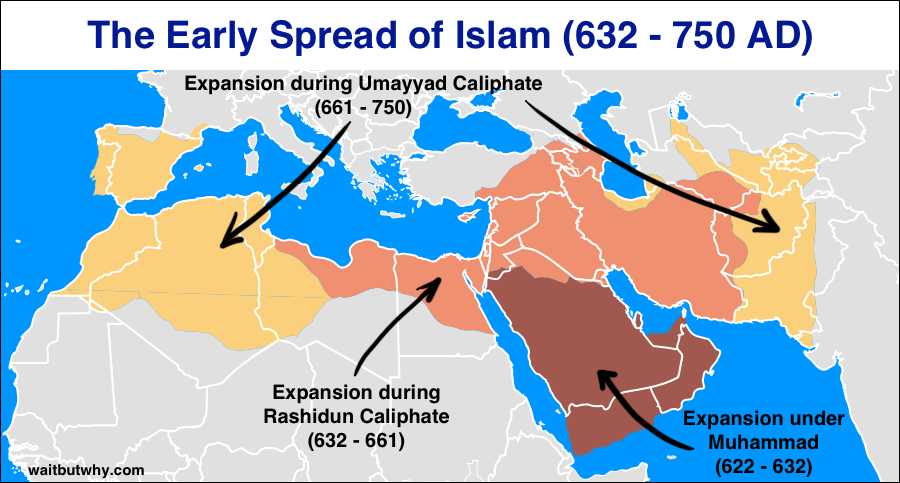
But as Islam swept the Earth, this early schism only deepened—it was here to stay.
Ingredient 2: Straight Lines
The land of Iraq has the coolest nickname of any land anywhere—The Cradle of Civilization—and for good reason. Ancient Iraqi history is as impressive as it gets. In particular, the fertile strip of Iraq in between the Tigris and Euphrates Rivers known as Mesopotamia is often credited with the birth of writing (cuneiform), the invention of the wheel, some of the earliest sailboats, calendars, maps, schools, and the origin of the 60-minute hour and 60-second minute.7 3,000 years later, when Alexander the Great conquered half the world, he chose that land to be his capital, selecting Babylon in particular for its treasures and its critical location between Europe and Asia. 1,000 years after that, the head of the great Abbasid Muslim dynasty built Baghdad on the same land to be the capital of the vast Muslim world, and for the next 500 years (until the Mongols stomped on it), Baghdad reigned as a world hub of learning and commerce and for a time, was the world’s largest city. There may be nowhere in the world with a history as rich as the land of Iraq.
The nation of Iraq, on the other hand, was created by two dicks with a pencil and ruler, and its history is mostly unpleasant.
By the beginning of the 20th century, the land of Iraq had been part of the Ottoman Empire for 400 years.8 There were several ethnic and religious groups on the land, left mostly free to keep to themselves and separate from the others. But when Germany and Co. took on France, Britain, and Russia in World War I, the Ottoman Empire elected to be part of the “and Co.”, which left them ultimately on the losing side. Bye bye Ottoman Empire.
During the war, Mark Sykes of Britain and François Georges-Picot of France got together with a pencil, a ruler, and a bottle of whiskey, and took to the map, carving the Ottoman Empire into nations and determining where their two nations and Russia would get to have spheres of influence after the war if they won.9
Regarding the whole “several ethnic and religious groups” thing and the natural boundaries of separation that had developed between them over centuries, George-Picot famously remarked, “Whatevs,” and with pencil in hand, Sykes is quoted as saying, “I should like to draw a line from the e in Acre to the last k in Kirkuk.”10 Here’s what they came up with:11
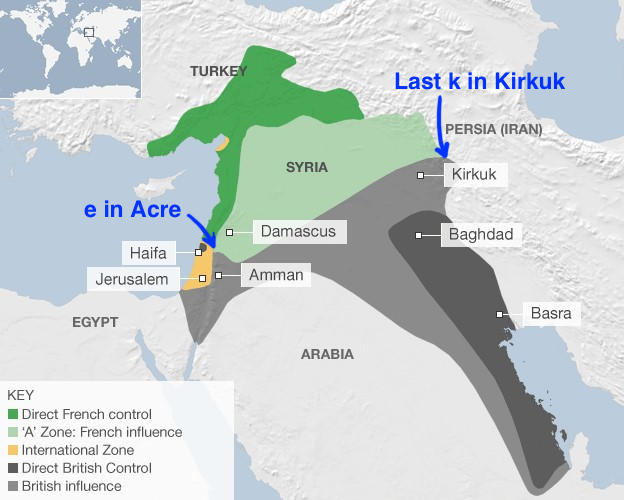
The thing about creating borders using a map, pencil, and ruler, is that it’s a terrible way to create borders. If you look at organically-created borders around the world—those that were formed over time by the local populations, based usually on ethnic and religious divisions, and often demarcated by mountains, rivers, or other natural barriers—they’re squiggly and messy. What’s a clear and satisfying straight-line-on-a-map border for imperial powers trying to keep things clean and simple for themselves is a complete disaster on the ground across the world where the actual place is.
When borders are drawn this way, two bad things happen: 1) Single ethnic or religious groups are sliced apart into separate countries, and 2) Different and often unfriendly groups are shoved into a nation together and told to share resources, get along, and bond together over national pride for a just-made-up nation—which inevitably leads to one group taking power and oppressing the others, resulting in bloody rebellions, coups, and sectarian violence. This isn’t that complicated.12
But since it wasn’t really their problem, Sykes and George-Picot just went ahead with it, and over the next few years, precise new borders were drawn, giving birth to modern day Iraq, Turkey, Syria, Jordan, Lebanon, and Kuwait. Here was Iraq’s new situation:
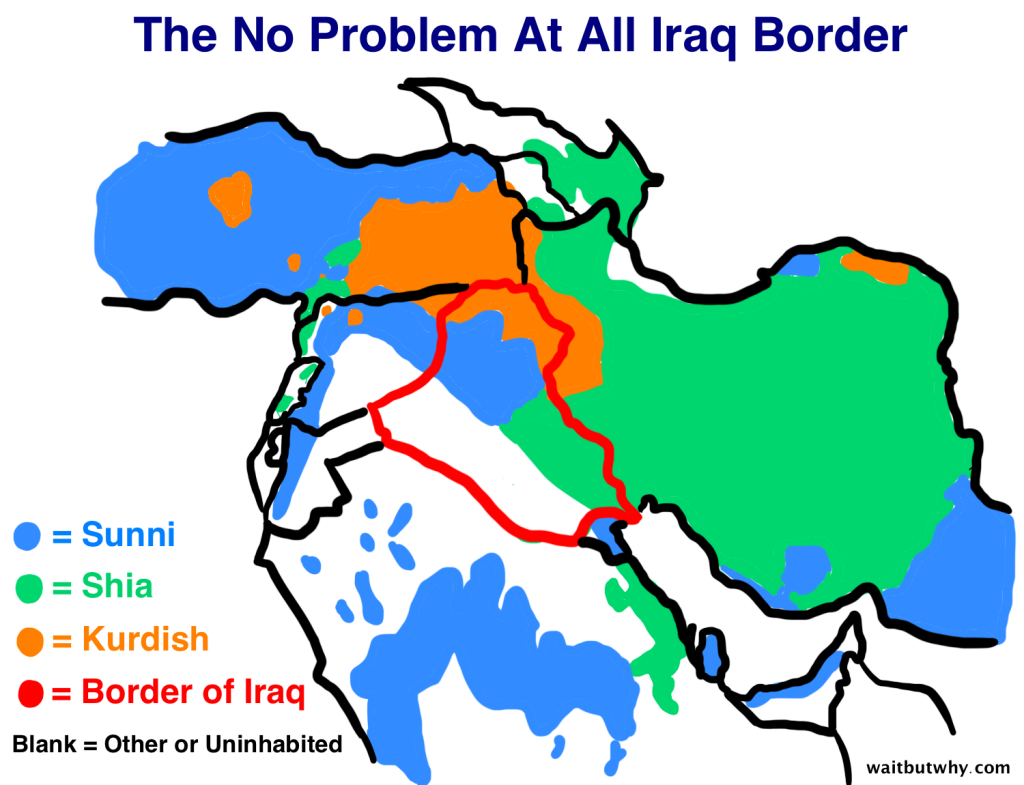
Can’t see why there’d be any issue here.
A Tight Lid
For any of you readers considering creating a new, tense nation of ethnic and religious groups who don’t like each other, I’ve been researching this shit all month and I have advice for you:
Your new nation is like a bubbling soup inside a pressure cooker and it’s gonna spew itself all over the kitchen unless you have one critical thing that can keep things in order: a tight lid.
The nation version of a tight lid can be either a strong western occupying power or an iron fist dictator with a scary military machine at his whim—without one of these, your nation will fall apart.13 Email me if you have any questions.14
The new nation of Iraq combined Ingredient 1 (Sunni and Shia Arabs living in the same area) with Ingredient 2 (a border that forces them into a nation together, along with a large group of Kurds) to create a tense pressure cooker.
Things were hot from the beginning, when the new Iraqis revolted against the British occupation in 1920. The British acted as a lid and crushed the revolt. After Iraq achieved independence and the British lid left, a series of military commanders took over the lid duties, stomping a number of revolts and killing each other in coups from time to time. In 1968, the Sunni Ba’ath Party took over, under the leadership of new president Ahmed Hassan al-Bakr and his ambitious vice president and general, Saddam Hussein.
By 1979, Saddam’s influence had grown to the point where he was kind of running the show, and finally he went to al-Bakr and was like, “You know what two cool things are? Murder and retirement. Ya know? I thought maybe you’d want one of those? And you could choose?” and al-Bakr stepped down, bringing Saddam Hussein, the tightest lid of them all, to power.
A lot of things sucked about the 24 year rule of Saddam. He started off in typical dictator fashion, calling together all the senior ranking members of government, and then reading out the names of those who were thought to be disloyal, 22 of whom were later taken out back and shot. He all but legalized “honor killings”—i.e. the tradition sometimes found in places run by Sharia Law whereby a man may kill a female relative if she dishonors her family, often without facing criminal charges. And he gave the world Uday Hussein.15
But Saddam’s worst crimes happened during the wars he started and their aftermath.
Worried that the 1979 Islamic revolution in Iran would inspire rebellion in Iraq’s large Shia majority, Saddam launched into the eight-year Iran-Iraq War, which killed over 100,000 Iraqis.16 Iraq’s Kurds, who have never wanted to be a part of Iraq, seized the opportunity in the chaos to try to form their own autonomous country, at times receiving support from the Iranians. The attempt failed, and toward the end of the war, Saddam embarked on the al-Anfal Campaign, a systematic genocide of the Kurdish north. One of the worst moments came in 1988, just as the war was winding down, when residents of the city Halabja were overcome by the smell of sweet apples after war planes flew by overhead, and then people and animals started dropping dead all over the city from gas poisoning. The gassing caused more deaths than 9/11. The entire al-Anfal campaign killed between 50,000 and 180,000 Kurds.
While we’re here, let’s pause for a second and talk about the Kurds.
The Iraqi Kurdistan Blue Box
This whole post was supposed to be about Iraqi Kurdistan, the Kurdish region in northeastern Iraq. But when I decided to go another direction, Kurdistan got left out. As a consolation, Kurdistan is being featured in Wait But Why’s first ever blue “aside” box (if you don’t see a blue box, try clearing your cache). Here are some things about Kurdistan:
Some notes from my visit:
Anyway, back to Saddam, who barely had time to take a shit after the Iran-Iraq War before starting the Persian Gulf War by invading Kuwait for its delicious oil reserves. This, as I learned from my third grade teacher, did not go well for Saddam, and again, Iraq’s oppressed groups, the Shia and the Kurds, tried to take advantage of the situation by attempting to overthrow Saddam. Saddam responded by tightening the lid and crushing the uprisings, killing 80,000 – 230,000 people in the process.19
Saddam was a brutal ruler, but for the most part, under his iron fist, Iraq was a stable country. We all know what happens next.
2003: Off Comes the Lid
Say what you want about the Bush Administration and their decision to invade Iraq and overthrow Saddam, but one thing is for sure: They were very, very wrong when they thought it would be a quick and easy war.
They knew they were removing a lid, but they seemed to think it was off a tupperware container of cookies, not a pressure cooker. And their plan to replace the wrought iron lid with a fresh sheet of democracy cellophane would have worked fine if it were a tupperware container of cookies. Just not if it were a pressure cooker.
So there’s the US, suddenly mired in hell and chaos for eight years, trying to fix a situation they weren’t prepared to fix, and which would ultimately be the Iraqi people’s problem, not theirs. Speaking of the Iraqi people, it’s time for another blue box.
The Life in Baghdad Blue Box
The people I got to know the best during my time in Kurdistan were three brothers from Baghdad who were visiting Kurdistan. They were born and raised in Baghdad, had lived there through the whole war, and spoke near-perfect English. I was ecstatic to find them, and spent two consecutive nights talking to them and asking them questions. Here are some things I learned:
Anyway, as unfortunate as the bloody years of US occupation were for everyone involved, by being there, the US was acting as a lid of some kind. While the US was there, nothing really bad could happen. Then, in 2011, the US left.
A Perfect Storm
Instability is the fertile soil that bad, scary things grow out of, and when the US left, Iraq had a new prime minister, a new government, a new and unfamiliar constitution, and an amateur, recently-trained army—not a stable situation.
The power pendulum had also just swung for the first time in decades. Iraq’s population is 55% Arab Shia, 18% Arab Sunni, and 21% Kurd (with others making up 6%). And despite being the smallest group of the three, Iraq’s Arab Sunnis have been in power over the other groups for almost the country’s whole history. For any living Iraqis, a Sunni government and suppressed Shia majority is all they know. Suddenly, in 2006, Iraq had a new government, led by a hard-line Shia, Nouri al-Maliki. A logical observer of history would probably suggest that it would be a wise move for al-Maliki to be inclusive of Sunnis, regardless of the past, since, as noted above, the country was not in a stable situation. Al-Maliki did just the opposite, arresting Sunni leaders, discriminating against Sunni civilians, and targeting Sunnis disproportionately for torture and violence. All of this exacerbated the instability by making the government less unified and competent, creating rage in the Sunni populous,20 and weakening the loyalty of a military, part of which hates its own government. The anti-al-Maliki feelings are so strong that many normally-peaceful Sunnis find themselves sympathizing or even supporting violent anti-government terrorists.
The power switch from Sunni to Shia has broader implications. If you look at the whole world of Islam, it’s clear that Sunni Islam is the vast majority (around 90%) and Shia Islam (around 10%) is just a small side branch:
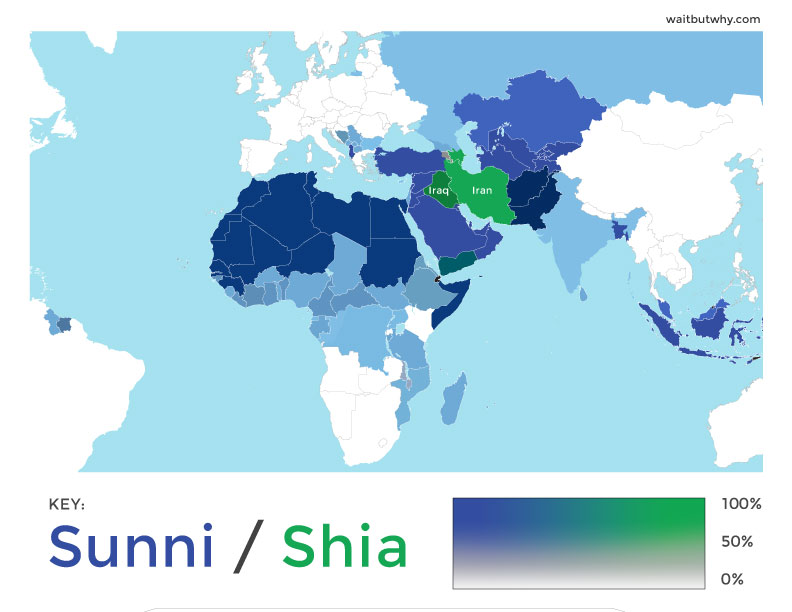
But when you look at the heart of the Middle East more closely, you can see why things are so complicated.
Here’s what the Middle East looked like when Saddam was in power versus when al-Maliki took over:21
Suddenly, Shias are in charge of countries all the way from Iran to the Mediterranean, creating a kind of Shia Axis. This is a great thing for the world’s largest Shia nation, Iran, and it scares the shit out of the region’s most powerful Sunni nation, Saudi Arabia. And what’s been happening is Saudi Arabia and Iran engaging in what is essentially a Cold War, vying for broader power, with conflicts like the Syrian Civil War and the current mess in Iraq serving as proxy wars that can tip the balance in the larger struggle. This is why Iran wants ISIS (a Sunni group) to disappear and why you keep hearing that the US and Iran might actually agree on something (though for different reasons). This is also why the Saudis have been rumored to have funded Sunni resistance movements in both Syria and Iraq, even possibly directing funds to groups like ISIS.22
Yet another factor playing into the trouble is the simultaneous instability of adjacent Iraq and Syria—this creates an unstable border, as well as a situation where the terrorist-fighting front is disjointed and without a shared national narrative to fight for. It also allows a terrorist group to hide in one country from trouble in the other.
Finally, western powers often provide a lid from afar when things erupt somewhere—but in this case, those powers have been gun shy since they just got out of a hideous war in the area and really really want to avoid getting involved. Up until Obama’s Mid-September speech, the US has done everything possible to avoid getting involved.
When you add this all together—an unstable and divided new government with an amateur, questionably-loyal army and an angry minority population who feels sympathy for anyone who will resist the government; the interests of a giant neighbor, Saudi Arabia, aligned with a government overthrow; a civil war next door; and a group of western powers who have been determined to stay out—you have the perfect storm for the fiercest of terrorist groups to emerge from the fringe and conquer.
ISIS
The beginnings of ISIS23—a Sunni jihadist group—can be traced back to 1999, when Abu Musab al-Zarqawi, a Jordanian jihadist, started the group because he was pissed off about a lot of things. After Zarqawi swore allegiance to al-Qaeda in 2004, this evolved into what became known as “al-Qaeda in Iraq,” and was one of those shadowy insurgent groups you kept reading about the US fighting during the war. When insurgent activity died down after the US troop surge in 2007, ISIS seemed on the decline and disappeared from relevance for a bit.

Al-Baghdadi
In 2010, after ISIS’s second leader was assassinated, Abu Bakr al-Baghdadi—a former scholar of Islamic studies24 and a US war prisoner back in 200425—took over and got the group back on track. He replenished their partially-killed-off leadership with dozens of Saddam’s old Ba’athist military personnel, who brought key experience to the group. Then in 2011, when the Syrian Civil War broke out, ISIS joined in as a rebel force26—which helped to train and battle-harden the group. ISIS’s behavior in Syria was so brutal and severe that they even started creeping out the other bad guy groups, including al-Qaeda, who finally had a tantrum in early 2014 and cut all ties with ISIS.
Up until early June 2014, only those who were carefully following the news knew about ISIS. But that’s when everything changed.
On June 5th, just hours after I purchased my non-refundable flight to Iraq, ISIS stormed into the country, taking control of the border, and started systematically conquering towns in the western part of the nation. And suddenly, everyone had heard of ISIS.
Two things were especially shocking about ISIS’s advance into Iraq. First, the horrifying, Genghis Khan-style way they conducted business—i.e. immediately round up and execute all men of authority, in this case anyone who was ever on the government payroll, and then execute anyone else who resisted their takeover.27 Second, the fact that in city after city ISIS attacked, the Iraqi military would flee the scene. This was partially because they were horrified of ISIS and partially because, as mentioned above, the Sunni members of the army weren’t that into fighting against a Sunni group to defend a government they hated. So western Iraq was folding quickly to ISIS, and by June 9th, they had captured Mosul, Iraq’s second biggest city.
The area of Syria and Iraq they had conquered (and are still in control of) is the size of Belgium. Al-Qaeda never conquered anything—they just killed people. So how did ISIS do it? In addition to the perfect storm of factors discussed above, including far more tacit support from masses of civilians than al-Qaeda ever had, ISIS has three qualities that make them so effective:
1) They’re brutal. No regard for human life is a helpful quality when trying to conquer a nation. This Amnesty International report details real accounts of ISIS brutality so scary it doesn’t seem real. An example of an excerpt in the report:
A witness to one such mass killing in Solagh, a village south-east of Sinjar city, told Amnesty International that on the morning of 3 August, as he was trying to flee towards Mount Sinjar, he saw vehicles with IS fighters in them approaching, and managed to conceal himself. From his hiding place he saw them take some civilians from a house in the western outskirts of Solagh:
“A white Toyota pick-up stopped by the house of my neighbour, Salah Mrad Noura, who raised a white flag to indicate they were peaceful civilians. The pick-up had some 14 IS men on the back. They took out some 30 people from my neighbour’s house: men, women and children. They put the women and children, some 20 of them, on the back of another vehicle which had come, a large white Kia, and marched the men, about nine of them, to the nearby wadi [dry river bed]. There they made them kneel and shot them in the back. They were all killed; I watched from my hiding place for a long time and none of them moved. I know two of those killed: my neighbour Salah Mrad Noura, who was about 80 years old, and his son Kheiro, aged about 45 or 50.”
ISIS has officially been the deadliest terrorist group in history. This tool maps out the activity of the world’s most prominent terrorist groups, and when you filter by “Most Victims,” ISIS comes up first, despite being around for less than a decade (their death count is more than double al-Qaeda’s lifetime total). The below screenshot of the tool shows terrorist groups ranked from most total killings (on the top left) to least (on the bottom right). Each mini-chart shows activity over time, with the red and yellow bars representing deaths and wounded, respectively:
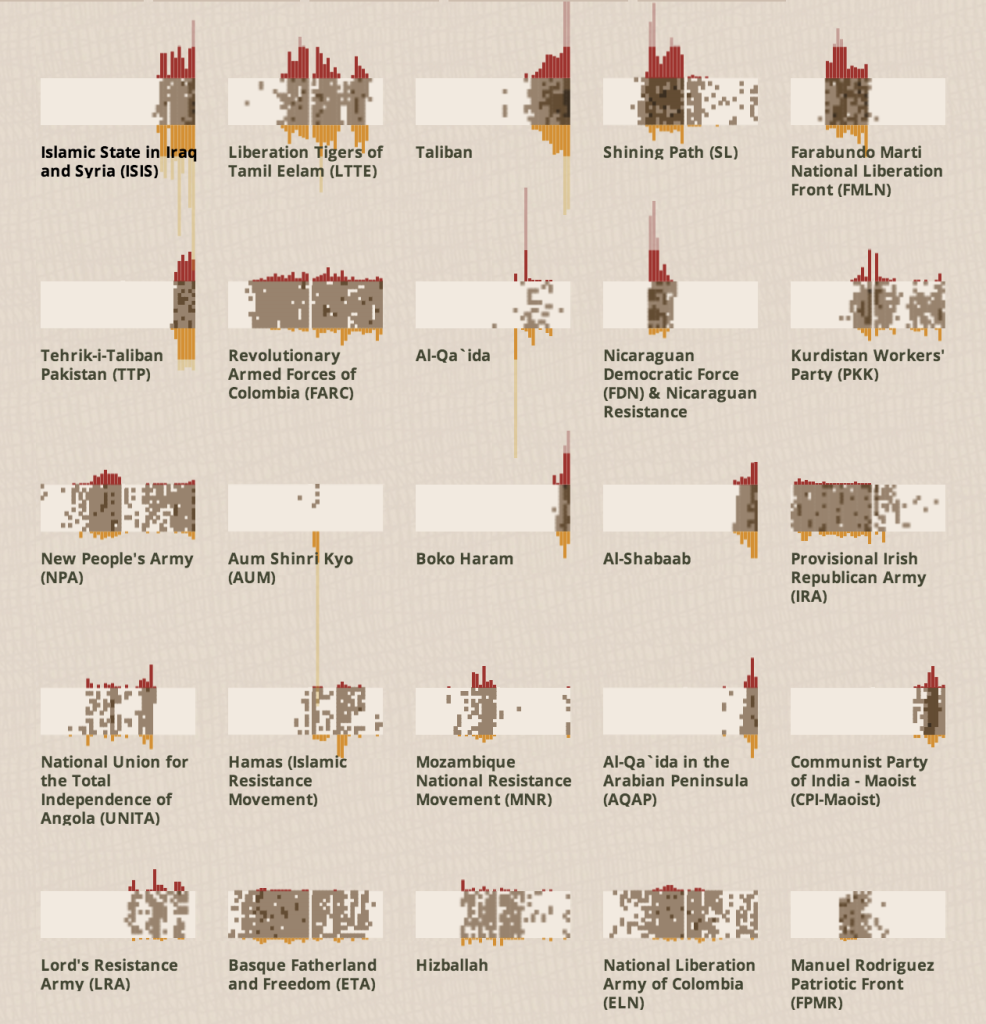
2) They’re sophisticated. ISIS functions like a well-run company—it knows how to recruit (ISIS forces are supposedly up to 50,000 in Syria and 30,000 in Iraq), it knows how to fundraise, and it’s incredibly organized. ISIS produces a thorough and professional annual report that details its killings and conquests in the same way a company would report on its revenue and gross margin. Here’s a chilling graphic from their 2013 report breaking down their various methods for the year’s 7,681 attacks:
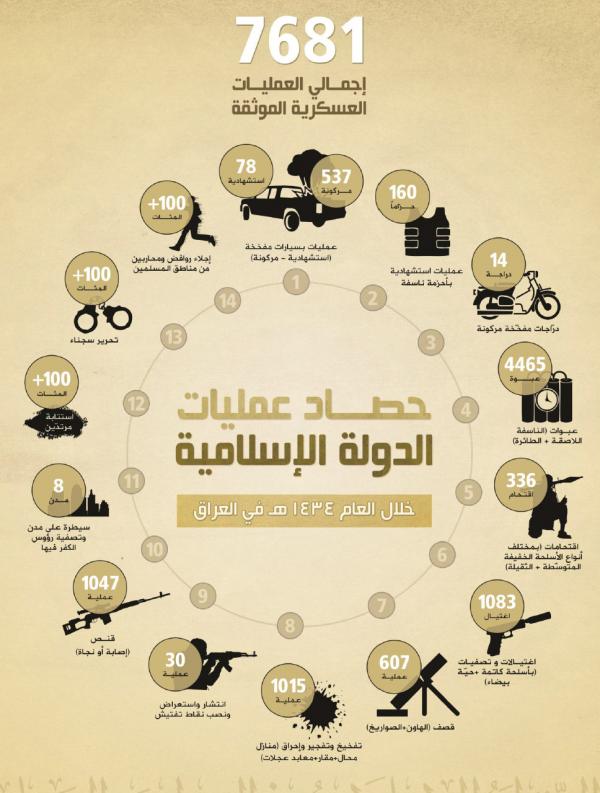
They’re also pros at social media. Aaron Zelin, an expert on jihadis at the Washington Institute, said that when it comes to social media, ISIS is “probably more sophisticated than most US companies.”
3) They’re incredibly rich. According to Iraqi intelligence, ISIS has assets worth $2 billion, making it by far the richest terrorist group in the world. Most of this money was seized after the capture of Mosul, including hundreds of millions of US dollars from Mosul’s central bank. On top of that, they’ve taken oil fields and are reportedly making $3 million per day selling oil on the black market, with even more money coming in through donations, extortions, and ransom. ISIS has also gotten ahold of an upsetting amount of high-caliber, US-made weapons and tanks that were for the use of the Iraqi army but left behind when the army fled. They’ve even gotten their hands on nuclear material that they found at Mosul University.
On June 29th, ISIS just fully went for it and proclaimed itself a caliphate—i.e. a global Islamic state—and commanded all the world’s Muslims to obey Abu Bakr al-Baghdadi, the grand caliph. Those living in ISIS-captured cities are getting a taste of what life in the new caliphate is like:
As for future goals, the short term goal is to establish an Islamic nation in the areas it currently controls, with some expansion of the boundaries. In the medium term, al-Baghdadi has declared that “this blessed advance will not stop until we hit the last nail in the coffin of the Sykes–Picot conspiracy”—i.e. until those pencil and ruler lines drawn after WWI are gone and all the nations are part of the new caliphate. In the long run, ISIS wants to expand its caliphate to the reaches of the first Muslim dynasty in 750 AD, and beyond:
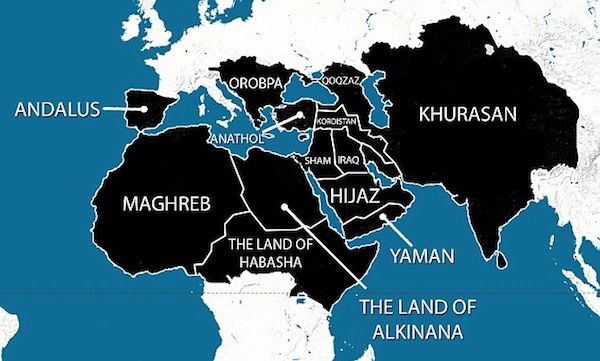
Some people have argued that this map wasn’t made by ISIS, but rather by their supporters. Even if that’s so, al-Baghdadi’s ambitions certainly seem to match, and exceed, those on that map. In July, al-Baghdadi put out a message to Muslims that assured them that ISIS “will conquer Rome and own the world.”
Over the past three months, as ISIS has marched through Iraq, 1.2 million Iraqis have become refugees. 700,000 of them are hiding under the protection of Kurdistan’s Peshmerga army. One of those 700,000 refugees is eight-year-old and now badly-damaged Mohammad, who was living a normal life in Mosul when ISIS attacked.
_______________
Five days after my visit to Khazir refugee camp, ISIS made an aggressive push forward into the scary-ish territory and captured the Khazir camp. The Peshmerga army retreated, instantly converting the area into scary-in-italics territory. That night, a black ISIS flag rose up over the camp where the Kurdish flag had been. Luckily, this happened after a few days of ISIS-Peshmerga fighting, and the refugees had time to run before ISIS arrived. But now, where do they go? People like Kamil, a police officer, cannot go back to Mosul—his name was on the government payroll, and he would be executed upon arrival. But without significant money, many refugees are not allowed into Kurdistan either. Some simply camped out on the road in the searing heat.
A few days later, with the help of US airstrikes, the Kurds recaptured the Khazir camp and a number of other areas ISIS had taken from them.
Since my visit, two new developments offer some hope that things could possibly turn around. The first is that the polarizing Nouri al-Maliki is no longer the Prime Minister. He has been forced out and replaced by another Shia leader, Haider al-Abadi. We’ll see if al-Abadi can cool off some of the Sunni rage al-Maliki’s administration ignited.
The second development happened on September 10th, when President Obama announced that the US would engage in a new campaign of airstrikes, both in Syria and Iraq, to try to defeat ISIS. Airstrikes are sure to slow ISIS down, but to take down and dismantle a group as shadowy, relentless, and fearless as ISIS, I doubt airstrikes will suffice. It’s going to be a lot harder than that.
_______________
Other stops: Russia, Japan, Nigeria, Greenland.
And North Korea.
Sources
William Montgomery Watt – Muhammad: Prophet and Statesman
William Montgomery Watt – Muhammad at Mecca
William Montgomery Watt – Muhammad at Medina
Majid Ali Khan – Muhammad, the Final Messenger
Bernard Lewis – Islam in History: Ideas, People, and Events in the Middle East
Muhammad Husayn Haykal – The Life of Muhammad
Richard C. Martin – Encyclopedia of Islam & the Muslim World
NPR – Chronology of the Shiite-Sunni Split
Pew Research – The Future of the Global Muslim Population
The Christian Science Monitor – Cause of Iraq’s Chaos: Bad Borders
The Guardian – First world war: 15 legacies still with us today
CIA World Factbook – Iraq
The World Bank – GINI Index
Time – The Sum of Two Evils
Sons of Saddam
Liam Anderson; Gareth Stansfield – The Future of Iraq: Dictatorship, Democracy, Or Division?
Al Jazeera – Islamic State ‘has 50,000 fighters in Syria’
Wall Street Journal – Refugee Numbers Grow as Civilians Flock to Iraqi Camps
Periscopic.com – A World of Terror
Amnesty International – Ethnic Cleansing on a Historic Scale: Islamic State’s Systematic Targeting of Minorities in Northern Iraq
New York Times – Sunni Extremists in Iraq Seize 3 Towns From Kurds and Threaten Major Dam
Welcome to the new note system. When I research, I come across a ton of facts, most of which don’t make the cut for the post. These notes will give me a place to sprinkle in fun extras I learned about, and sometimes just to expound on a point in the post without breaking up the flow. And since the posts are long, those who don’t want to spend that long here can skip the notes, while those who want to dig in should check them out. Anyway, this note actually had a boring source-related purpose so let’s get to it: Any historical account from 1400 years ago will likely have hazy parts of the story or areas where historians disagree—and even more so when the story involves religion. My main source for this post are three books written by widely respected Islam scholar, William Montgomery Watt, with some additional information taken from the writings of Bernard Lewis, Muhammad Husayn Haykal, Martin Lings, Majid Ali Khan, and Richard C. Martin—links to the sources at the bottom of the post.↩
Sorry, I’m in the honeymoon phase with the new note system and wanted to come hang out here again. Let’s just quickly discuss how crazy it is that Muhammad’s parents never knew that their son was important. Like, his mother fell ill and before she died she thought, “I hope my little six-year-old makes something of his life” and she has no idea what happened. Imagine what she’d think if someone could have shown her the world in 2014, 1400 years in the future, and told her that 1.6 billion people revered her son. I know I make this point a lot about different people, and I’m going to continue to make it when I come across it because it’s crazy. Note, by the way, that you’re scrolling inside of a footnote. Cool right?↩
Or, depending on what you believe, it was the first time he started making up stories of being visited by an angel.↩
The word Shia derives from “Shiatu Ali” which means “followers of Ali.” While we’re here, I’m as confused as you are about Shia/Shi’a/Shiite—I read a bunch of things and it didn’t become clearer when to use which. I’m just gonna stick with Shia.↩
You’ll notice Spain included in the 8th century Muslim world. It would stay that way for almost 800 years until the land would be reconquered by Christians in 1491, who would then spend the next 250 years systematically purging the land of its Islamic tradition. If you look hard, you can still find remnants of Islam in Spain—one example is the word “Ojala,” which means “I hope” or “Let’s hope,” but its actual definition is “May God will it” and is derived from “O Allah.”↩
Speaking of where Islam exists today, here’s a cool “weighted” map that shows each country’s Muslim population.↩
And if you’re into the Bible, both the site of the Garden of Eden and Ur, the hometown of Abraham, are within the borders of modern day Iraq↩
Here’s a gif that shows the Ottoman Empire expansion timeline, if you’re interested.↩
Here’s a map that shows what the Middle East looked like in 1914, right before WWI. As you can see, most of it was already under the influence of European imperial powers, with the waning Ottoman Empire as the exception—so that was what was left to be carved up by Sykes and George-Picot after the war.↩
Surprisingly, one of those two quotes is actually real. Source: A Line in the Sand, James Barr, p.12↩
Here’s a photo of the original map they drew on.↩
Of course, the same principle is behind most of the African civil wars—remember the history chart in the Nigeria post? Another striking example is the creation of the Afghanistan/Pakistan border in 1893 by another aloof British guy—this line (called the Durand Line) sliced through the middle of the ethnic Pashtun population, creating a huge amount of ethnic strife and ultimately turning the Durand line into a Taliban hotbed. Over a century later, this is still causing massive trouble. Great map showing this here.↩
A quintessential example of the Tight Lid Principle is Yugoslavia, a nation also formed in the wake of WWI, which consisted of modern day Slovenia, Croatia, Bosnia and Herzegovina, Serbia, Montenegro and Macedonia. The tight lid in Yugoslavia’s case was dictator Josip Broz Tito. When Tito died in 1980, the repressed tensions all boiled to the surface, and the country broke up soon after, with a bunch of blood shed in the process.↩
Don’t actually.↩
Welcome to the Uday Hussein footnote! Today, in this footnote, we’ll make a bullet list about Uday, literally the worst person who has ever lived:
I hope you enjoyed the Uday Hussein footnote! All of these nuggets were gathered from two sources: this documentary and this article.↩
Some counts put the toll as high as 500,000↩
Imagine if some powerful faraway country decided to draw new borders in Europe which cut France in three pieces, making the French population an oppressed minority group in Spain, Italy, and Germany with no country of their own. The Kurds’ situation is shitty.↩
brag↩
Many suggest that the George H.W. Bush Administration misled the Kurds and Shias to believe that the US was behind their uprisings and would protect them if necessary.↩
This map comparison shows the religious makeup of Baghdad’s neighborhoods in 2005 vs 2007, illustrating just how tense the sectarian animosity has become since al-Maliki took over. Source.↩
Lebanon’s Shia population represents the majority of Muslims in Lebanon, but not the majority of the population (there is a significant Christian population). Lebanon’s government is not totally Shia run either—they have a minority of seats in the Parliament—but again, they carry more power in government than do Lebanon’s Sunni population, and Hezbollah has a large amount of popular support and more power than their seat number would suggest).↩
Saudi Arabia denies this.↩
ISIS has a lot of names. First of all, ISIS doesn’t even stand for what people think it does (Islamic State of Iraq and Syria), it stands for Islamic State of Iraq and al-Sham. Al-Sham refers to the Levant, the region that encompasses Syria, Jordan, Lebanon, and Israel-Palestine. So the second common name of the group, ISIL (Islamic State of Iraq and the Levant) is a synonym for the first. Before either of those was ISI (Islamic State of Iraq), and as of June, the group has renamed itself IS (Islamic State). Some leaders within Islam reject the name Islamic State and call it the less-glamorous QSIS (al-Qaeda Separatists in Iraq and Syria). I’m going to stick with ISIS.↩
According to this pro-ISIS biography, which may or may not be accurate↩
Supposedly, as al-Baghdadi was leaving the prison after his release, he said to one of the guards, “I’ll see you in New York.”↩
This makes sense, since the Syrian government is Shia and the exact kind of entity ISIS wants to bring down↩
ISIS has a habit of videotaping their executions and putting them online. Kind of a weird thing to link to here, so I won’t, but you can find these videos on liveleak.com if you want to give yourself nightmares.↩
This practice has affected 125 million women worldwide, according to the WHO, most of them in Africa. Apparently 91% of Egyptian women undergo genital mutilation.↩
The post From Muhammad to ISIS: Iraq’s Full Story appeared first on Wait But Why.

Daniel Hashimoto is a Dreamworks animator and an awesome dad to boot. That’s how his son became Action Movie Kid.
The series of short videos features Daniel’s son doing everything from superhuman feats to destroying toy aisles with lightsabers. From The Creator’s Project:
“Upon viewing the lightsaber and Iron Man videos,” Hashimoto told us, “My son replied, ‘Why if I did that for real-sies, Dad?’” Heart-melting.
Check out some of the videos after the break…
(via Gizmodo)
‘So if we love someone, we should train in being able to listen. By listening with calm and understanding, we can ease the suffering of another person.’ ~Thich Nhat Hanh
While the idea of being more compassionate is appealing to many people, what stands in the way is that we get irritated by other people, often actually strongly disliking them.
How can you be compassionate with others when they irritate you, rub you the wrong way, make you angry?
It’s difficult. I have a hard time with this fairly often, so I’ve been studying it inside myself. What’s really amazing is how much we get in our own way.
My “self” is the thing that stands in the way of true compassion, I’ve been learning.
And my “self” is almost always putting itself in the center of the universe, demanding things, and becoming angry when it doesn’t get what it feels it deserves.
I’m really blown away by how much I think about myself, and how often I believe (without admitting it to myself) that I deserve to be treated a certain way, that others should act the way I want them to act.
Try monitoring those kinds of thoughts in your own head:
There are many other variations, but you get the idea. These are self-centered thoughts. I have them all the time — way more than I would have believed before I started monitoring them.
It’s natural for us to have these self-centered thoughts. When we are kids, we believe we’re the center of the universe. When we grow up, we mostly still believe this, and it’s probably a self-defense mechanism to create a universe where we’re at the center of it, entitled to what we want.
But it gets in the way of compassion. Let’s see what happens when we remove ourselves, get out of the way.
Compassion starts with empathy — imagining putting ourselves in the mind of another person, and imagining what they’re going through. We are probably wrong about what they’re going through, because we can’t know, but without this imaginative process we can’t have compassion.
Once we’ve empathized, and feel their suffering, the second half of compassion is wanting to end that suffering, and taking action to ease that suffering in some way.
So empathy is incredibly important, but if we are thinking about ourselves first, and only ourselves, we can’t empathize.
We must get ourselves out of the way, and think of the other person. When we think about how we should be treated, what we want, how something will affect us, we cannot also be thinking of the other person and how something will affect them, how they should be treated, what they want.
So to empathize, we must get out of the way. Be self-less rather than selfish.
How do we do that? Honestly, I’m still learning.
The first step for me has been to become aware of my selfish thinking. And it happens all the time.
The next step, when I recognize this selfish thinking, is to pause, and try to put my mind in the mind of the other person, to empathize, to try to understand what they’re going through. To feel their suffering, and then to want to end it.
And then ask, how can I end that suffering?
Get yourself out of the way, so that compassion becomes possible.
I’m happy to share the latest video interview in my Habits of Entrepreneurs series: Jennifer Patee, founder of Basic Training in San Francisco. Jenn started Basic Training in 2008 with the idea that the best workout program is the one you actually want to use. And so she has turned working out into a social, fun, incredible experience that people keep coming back to.
You can watch the short-version of the video below (about 3 mins) for free or get the full version (nearly an hour), along with show notes, by subscribing.
In the full video, Jenn shares her amazing personal story that got her from unhealthy to healthy … thoughts on keeping people coming back to work out consistently, working out in a healthy manner, making health and fitness social, running and eating healthy. It’s a great interview!
Also see: Jenn’s campaign for a Pop-up Fitness Hub in Hayes Valley, San Francisco.
It’s no secret that I love Torchy’s. Truth be told, I often go there just to order queso and guacamole because it’s my ultimate guilty pleasure. I recently officially ordered off their secret menu for the first time and let’s just say I will never look at Torchy’s the same way again.
As I called in my order, I was sure I would get laughed at or have the person on the other end reply with, “Umm… I’ve never heard of that.” Or even worse, “Umm… you’re not allowed to order that, you’re not in the club.” Thankfully, it went as smoothly as my normal queso order.
As I went to pick up my order, I could hardly control my excitement; I had officially ordered off the secret menu… I wouldn’t be surprised if they gave me a sticker for my solid detective work. Unwrapping the “Ace of Spades” amazingness, I couldn’t Instagram fast enough. The picture didn’t really do it justice, so just take my word for it, or better yet, try one yourself!
Once I instagrammed the photo I had many, many people asking about the details of the sacred menu. What do you know? You can find anything on the Internet. Thanks to emails from blog followers and reddit, I was able to come up with “The Secret Menu.”
( ACE OF SPADES)
Behold:
JACK OF CLUBS – a fried egg, potatoes, black beans, crips corn tortilla strips, shredded cheese, cilantro, sour cream and Diablo. Served on a flour tortilla.
ACE OF SPADES- a jalapeno sausage link, grilled brisket, a fried egg, green chile queso, cilantro, cotija cheese, sour cream and Diablo. Served on a flour tortilla.
TRAILER PARK HILLBILLY STYLE – fried chicken, chorizo, chopped bacon, green chiles, green chile queso, shredded cheese, pico de gallo, pablano ranch on the side. Served on a flour tortilla.
MAD COW- fajita beef, black beans, grilled corn, jack cheese, creamy chipotle and cilantro. Served on a flour tortilla.
THE HIPSTER- panko fried tuna, with green chilies, chopped bacon, black bean relish, cotija cheese, avocado sauce, cilantro and a wedge of lime. Served on a flour tortilla.
THE MADATOR- chopped brisket, grilled jalapeno, pickled onions, jack cheese, avocado, sour cream and cilantro. Served with tomatillo sauce on a crisp corn tortilla wrapped in a flour tortilla.
GREEN CHILE PORK MISSIONARY STYLE- green chile pork, pickled onions, guacamole, jack cheese, cilantro, creamy chipotle on a crisp corn tortilla inside of a flour tortilla